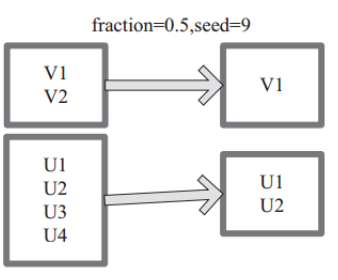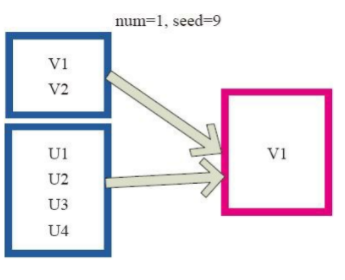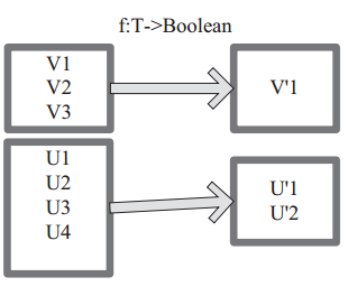取数据超过内存限制的问题-解决方案(sample,takeSample,filter)
遇到的问题
在处理数据过程中,遇到需要取(n)个数的问题,而当样本量过大的时候,就不能简单的take(n),这类问题一般有两种情况:
- 有序取 TopN
- 无序取 N
先来讨论无序取N的情况:
- sample函数
- sample(boolean, fraction,seed) : 按比例抽取
- 返回一个新的RDD
withReplacement:元素可以多次抽样(在抽样时替换)
- withReplacement=true,表示有放回的抽样
- withReplacement=false,表示无放回的抽样
fraction:期望样本的大小作为RDD大小的一部分, 当withReplacement=false时:选择每个元素的概率;分数一定是[0,1] ; 当withReplacement=true时:选择每个元素的期望次数; 分数必须大于等于0
seed:随机数生成器的种子
图 11中 的 每 个 方 框 是 一 个 RDD 分 区。 通 过 sample 函 数, 采 样 50% 的 数 据。V1、 V2、 U1、 U2、U3、U4 采样出数据 V1 和 U1、 U2 形成新的 RDD

图 sample 算子对 RDD 转换
- takeSample函数
- takeSample(boolean, sampleNum,seed) : 按固定数量抽取
- 返回一个Array[T]; 该方法仅在预期结果数组很小的情况下使用,因为所有数据都被加载到driver的内存中
- takeSample函数先是计算fraction,也就是采样比例,然后调用sample函数进行采样,并对采样后的数据进行collect(),最后调用take函数返回num个元素
withReplacement:元素可以多次抽样(在抽样时替换)
- withReplacement=true,表示有放回的抽样
- withReplacement=false,表示无放回的抽样
num:返回的样本的大小
seed:随机数生成器的种子

图 takeSample算子对RDD转换
再来看一下有序取 TopN的情况:
- filter函数
- 函数功能是对元素进行过滤,对每个元素应用 f 函 数,返回值为 true 的元素在RDD中保留,返回值为 false 的元素将被过滤掉。 内 部 实 现 相 当 于 生 成 FilteredRDD(this,sc.clean(f))
- 若是单列无法过滤,可以手动设置过滤位
- 有点遗憾的是无法准确的取固定量的数
图中每个方框代表一个 RDD 分区, T 可以是任意的类型。通过用户自定义的过滤函数 f,对每个数据项操作,将满足条件、返回结果为 true 的数据项保留。例如,过滤掉 V2 和 V3 保留了 V1,为区分命名为 V'1。

图 filter 算子对 RDD 转换
附:takeSample源码
def takeSample(
withReplacement: Boolean,
num: Int,
seed: Long = Utils.random.nextLong): Array[T] =
{
val numStDev = 10.0
if (num < 0) {
throw new IllegalArgumentException("Negative number of elements requested")
} else if (num == 0) {
return new Array[T](0)
}
val initialCount = this.count()
if (initialCount == 0) {
return new Array[T](0)
}
val maxSampleSize = Int.MaxValue - (numStDev * math.sqrt(Int.MaxValue)).toInt
if (num > maxSampleSize) {
throw new IllegalArgumentException("Cannot support a sample size > Int.MaxValue - " + s"$numStDev * math.sqrt(Int.MaxValue)")
}
val rand = new Random(seed)
if (!withReplacement && num >= initialCount) {
return Utils.randomizeInPlace(this.collect(), rand)
}
val fraction = SamplingUtils.computeFractionForSampleSize(num, initialCount, withReplacement)
var samples = this.sample(withReplacement, fraction, rand.nextInt()).collect()
// If the first sample didn't turn out large enough, keep trying to take samples;
// this shouldn't happen often because we use a big multiplier for the initial size
var numIters = 0
while (samples.length < num) {
logWarning(s"Needed to re-sample due to insufficient sample size. Repeat #$numIters")
samples = this.sample(withReplacement, fraction, rand.nextInt()).collect()
numIters += 1
}
Utils.randomizeInPlace(samples, rand).take(num)
}



【推荐】编程新体验,更懂你的AI,立即体验豆包MarsCode编程助手
【推荐】凌霞软件回馈社区,博客园 & 1Panel & Halo 联合会员上线
【推荐】抖音旗下AI助手豆包,你的智能百科全书,全免费不限次数
【推荐】博客园社区专享云产品让利特惠,阿里云新客6.5折上折
【推荐】轻量又高性能的 SSH 工具 IShell:AI 加持,快人一步